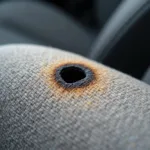Ensuring your car seat belts are in optimal condition is paramount for safety. If you’re experiencing issues with your seat belts, this comprehensive guide will provide you with the necessary information to diagnose and potentially repair them.
Understanding Car Seat Belt Mechanics
Before delving into repairs, it’s crucial to grasp the basic mechanics of a car seat belt system. A typical system comprises:
- Webbing: The strong, flexible strap that restrains you.
- Retractor: A device that houses the webbing and allows it to extend and retract smoothly.
- Buckle: The locking mechanism that secures the seat belt.
- Pillar Loop & Anchor Points: These secure the seat belt to the vehicle’s frame.
Common Car Seat Belt Problems and Solutions
Several issues can arise with car seat belts, some requiring professional attention. Let’s explore common problems and their potential fixes:
1. Seat Belt Won’t Retract
Possible Causes:
- Twisted Webbing: Over time, the webbing inside the retractor can twist, hindering retraction.
- Dirt and Debris: Accumulation of dirt or debris within the retractor mechanism can obstruct movement.
- Worn Retractor: A worn-out retractor spring or internal damage can cause retraction failure.
Solutions:
- Inspect and Untwist Webbing: Check for any twists in the webbing and gently untwist them.
- Clean the Retractor: Use a vacuum cleaner with a crevice attachment to remove loose debris. If necessary, use compressed air to dislodge stubborn dirt.
- Retractor Replacement: If cleaning and untwisting don’t resolve the issue, the retractor likely needs replacement.
2. Seat Belt Locks Up Too Easily
Possible Causes:
- Sudden Braking: The retractor is designed to lock during sudden stops. If it locks frequently under normal braking, the sensitivity might be too high.
- Damaged Retractor: A malfunctioning retractor can lock prematurely.
- Seat Belt Angle: If the seat belt is pulled too quickly or at an awkward angle, it can trigger the locking mechanism.
Solutions:
- Check for Obstructions: Ensure nothing is obstructing the seat belt’s path, causing it to lock unnecessarily.
- Professional Inspection: If the issue persists, have a mechanic inspect the retractor for damage or misalignment.
3. Seat Belt Buckle Malfunction
Possible Causes:
- Dirt or Debris: Accumulation of dirt, grime, or objects lodged in the buckle can prevent proper latching or release.
- Worn Buckle: Constant use can wear down the buckle’s internal components, leading to malfunctions.
- Bent or Damaged Components: Physical damage to the buckle or its release button can affect its functionality.
Solutions:
- Clean the Buckle: Use a stiff brush and a vacuum cleaner to remove dirt and debris from the buckle’s latching mechanism.
- Lubricate the Buckle: Apply a small amount of dry lubricant to the buckle’s moving parts to ensure smooth operation.
- Buckle Replacement: If cleaning and lubrication don’t resolve the problem, the buckle likely requires replacement.
4. Frayed or Torn Seat Belt Webbing
Possible Causes:
- Wear and Tear: Over time, the webbing can weaken and fray due to constant use, exposure to sunlight, and general aging.
- Sharp Objects: Contact with sharp objects, like keys or tools, can cut or tear the webbing.
- Chemical Exposure: Exposure to harsh chemicals or cleaning agents can weaken the webbing’s fibers.
Solutions:
Never attempt to repair frayed or torn webbing yourself. Seat belts are designed for one-time use in an accident. A compromised webbing significantly reduces its effectiveness in a collision. Always replace a seat belt with frayed or torn webbing immediately.
When to Seek Professional Help
While some seat belt issues can be addressed with simple cleaning or adjustments, others necessitate professional attention. It’s crucial to consult a qualified mechanic if:
- The problem persists after attempting DIY solutions.
- You suspect damage to the retractor or other internal components.
- The seat belt webbing shows signs of fraying, tearing, or significant wear.
- You’re uncomfortable handling any aspect of car seat belt repair.
Remember, car seat belts are critical safety devices. Professional repair ensures your safety and peace of mind.
Car Seat Belt Maintenance Tips
Prolong the lifespan of your car seat belts and ensure their optimal performance with these maintenance tips:
- Regular Inspection: Regularly inspect your seat belts for signs of wear, fraying, cuts, or any unusual sounds during operation.
- Keep them Clean: Clean the webbing and buckle regularly using a mild soap solution and a soft brush.
- Avoid Harsh Chemicals: Refrain from using harsh chemicals or cleaners on the webbing, as they can weaken the fibers.
- Address Issues Promptly: Don’t ignore any issues with your seat belts. Address them promptly to prevent further damage and ensure your safety.
Conclusion
Understanding how to repair car seat belts empowers you to address minor issues and recognize when professional help is necessary. Remember, maintaining your car seat belts ensures your safety and the safety of your passengers. If you encounter any problems beyond your comfort level, don’t hesitate to seek assistance from a qualified mechanic.
FAQs
Can I sew a torn car seat belt?
No, never attempt to sew or repair a torn car seat belt. This compromises its strength and renders it ineffective in an accident.
How much does it cost to replace a car seat belt?
The cost varies depending on the make and model of your vehicle and whether you opt for OEM or aftermarket parts. On average, expect to pay between $150 to $400 per seat belt.
How long do car seat belts last?
While there’s no set lifespan, car manufacturers recommend replacing seat belts after a significant impact, even if there’s no visible damage.
Can I replace a car seat belt myself?
Replacing a car seat belt requires specialized tools and knowledge of your vehicle’s safety systems. It’s best left to qualified professionals.
How can I tell if my car seat belt needs to be replaced?
Signs include fraying, tearing, cuts, slow retraction, locking too easily, or difficulty latching the buckle.
Need help with car seat belts or other car upholstery repairs? Check out these helpful resources:
- How to repair leather car seats stitching
- Best leather car seat repair
- How to repair a ripped leather car seat seam
- Car seat upholstery repairs
- Repair tear in leather car seat
For further assistance, feel free to reach out to our 24/7 customer support team via WhatsApp: +1(641)206-8880 or Email: [email protected].



